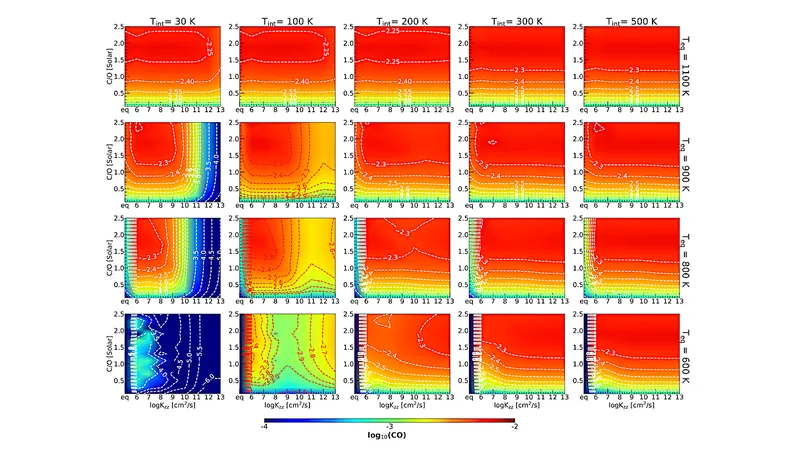
Unraveling the Mysteries of Exoplanet Atmospheres: What Metallicity and Interior Temperature Reveal
2024-10-23
Author: Arjun
Characterizing the atmospheres of exoplanets is crucial for understanding their fundamental properties, such as metallicity, carbon-to-oxygen (C/O) ratios, and intrinsic heat levels. A significant challenge in this research is the uncertainty surrounding vital atmospheric physics parameters, including the strength of vertical mixing — a key concept in determining how chemicals interact and evolve in these alien environments.
In recent studies utilizing advanced modeling tools like PICASO and photochem, researchers investigated how various atmospheric properties are influenced by planetary characteristics, including metallicity, C/O ratios, equilibrium temperature (Teq), interior temperature (Tint), and the coefficient of vertical mixing (Kzz) — particularly in hydrogen-rich atmospheres.
The analysis encompassed a wide range of Teq, ranging from 400 K to 1600 K, thus studying cold, warm, and hot exoplanets. Furthermore, the investigation examined Tint values spanning from 30 K to 500 K, allowing for a comprehensive understanding of sub-Neptunes to immense gas giants. Remarkably, the study found that gases like carbon monoxide (CO) and carbon dioxide (CO2) exhibit significantly different behaviors based on the internal temperature of the planets. For instance, sub-Neptunes with cooler interiors behave distinctly from Jupiter-sized planets, even when exposed to the same equilibrium temperatures.
A critical highlight of the findings is that volatile compounds such as carbon disulfide (CS) and carbon disulfide (CS2) can play a vital role in carrying sulfur inventory within the upper layers of atmospheres, particularly at temperatures of Teq ≤ 600 K — below which sulfur dioxide (SO2) becomes less prominent. The research also illustrates that for planets with low Teq and cold interiors (Tint ≤ 100 K), the CO/CH4 ratio can dwindle down to about 1. This drastic shift emphasizes the complex interplay between chemical compositions in these distant worlds.
The study revealed a sophisticated relationship governing the prevalence of photochemical haze precursor molecules in planetary upper atmospheres, dependent on a mixture of factors including C/O ratio, Kzz, Teq, and Tint — particularly for sub-Neptunes.
Additionally, the research briefly touches on the prospect of fully integrating PICASO and photochem models to create self-consistent radiative-convective-photochemical equilibrium frameworks. This pioneering work could pave the way for further insights into atmospheric behaviors on diverse exoplanetary bodies.
As we continue to gaze into the cosmos, these findings not only deepen our understanding of exoplanet atmospheres but also enhance our ability to detect signs of habitability beyond our solar system. The quest to comprehend the atmospheres of distant worlds is unfolding new chapters in astrophysics and planetary science, offering tantalizing hints about the possibilities of life elsewhere in the universe.
For those eager to delve deeper into the intricacies of these studies, the original paper offers a treasure trove of information and is available for reference at arXiv:2410.17169.




 Brasil (PT)
Brasil (PT)
 Canada (EN)
Canada (EN)
 Chile (ES)
Chile (ES)
 España (ES)
España (ES)
 France (FR)
France (FR)
 Hong Kong (EN)
Hong Kong (EN)
 Italia (IT)
Italia (IT)
 日本 (JA)
日本 (JA)
 Magyarország (HU)
Magyarország (HU)
 Norge (NO)
Norge (NO)
 Polska (PL)
Polska (PL)
 Schweiz (DE)
Schweiz (DE)
 Singapore (EN)
Singapore (EN)
 Sverige (SV)
Sverige (SV)
 Suomi (FI)
Suomi (FI)
 Türkiye (TR)
Türkiye (TR)